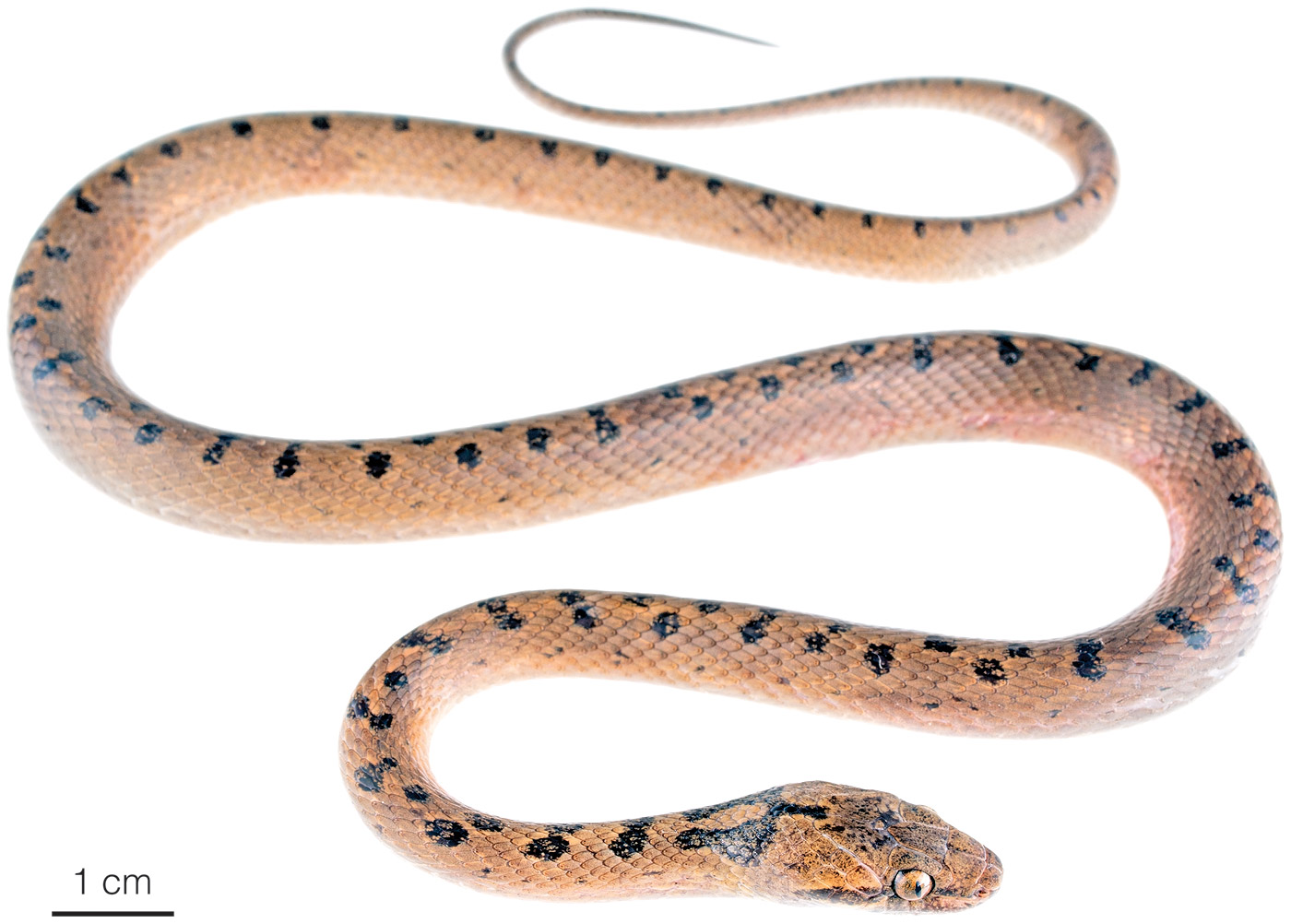Published May 11, 2024. Open access. | Purchase book ❯ |
Jubones Cat-eyed Snake (Leptodeira misinawui)
Reptiles of Ecuador | Serpentes | Colubridae | Leptodeira misinawui
English common name: Jubones Cat-eyed Snake.
Spanish common name: Ojo de gato del Jubones.
Recognition: ♂♂ 61.8 cmMaximum distance from the snout to the tip of the tail. Snout–vent length=44.5 cm. ♀♀ 52.3 cmMaximum distance from the snout to the tip of the tail..1 Leptodeira misinawui is the only member of its genus known to occur in the xeric inter-Andean valley of the Río Jubones. It can be identified from other snakes in the valley by having the following combination of features: dorsal scales arranged in 19–21 rows at mid-body, vertebral and paravertebral rows not enlarged; vertically elliptical pupils, and a unique coloration.1 The dorsum is light brown with a longitudinal series of dark brown intercalary paravertebral blotches on each side, some of which are fused with the corresponding opposite blotch, but never forming a zig-zag line (Fig. 1).1 This species differs from Imantodes and Dipsas by having an acutely rounded, instead of truncated snout and by having vertebral scales not enlarged. From L. ornata, it differs by having considerably smaller dorsal blotches and a greater number of them (54–72 vs 30–47).1

Figure 1: Subadult female of Leptodeira misinawui from Poetate, Azuay province, Ecuador.
Natural history: Leptodeira misinawui is an extremely rare snake that inhabits a xeric inter-Andean valley with low shrubs and scattered herbaceous vegetation.1 Almost nothing is known about the habits of this species, other than it is active at night and apparently more common near bodies of water. One individual was seen active at night near shrubs and another one besides an artificial pond.1
Conservation: Critically Endangered Considered to be facing imminent risk of extinction.. Leptodeira misinawui is proposed to be included in this category because new estimates indicate that the species meets the following IUCN2 criteria: extremely small distribution range (~30 km2) characterized by strong human intervention, where deforestation due to agricultural and urban expansion are the main threat.1 Leptodeira misinawui is included among the top five snake species closest to extinction in Ecuador primarily because it is known from less than five localities in heavily human-modified habitats, none of which are close to protected areas.
Distribution: Leptodeira misinawui is endemic to an area of approximately 30 km2 along the upper basin of the Río Jubones, Azuay Province, southern Ecuador (Fig. 2).

Figure 2: Distribution of Leptodeira misinawui in Ecuador. The star corresponds to the type locality: Poetate, Azuay province, Ecuador. See Appendix 1 for a complete list of the presence localities included in the map.
Etymology: The genus name is derived from the Greek words leptos (=thin) and deire (=neck).3 The specific epithet misinawui comes from the Quechua-Cañari words misi (=cat) and ñawui (=eye), in reference to the vertically elliptical pupil.1 The name also honors the Quechua-Cañari culture of southern Ecuador.
See it in the wild: The Jubones Cat-eyed Snake is an extremely rare species, with less than 10 observations in total. At the type locality, this snake is found at a rate of about once every few years, especially in thickets near water sources at night.
Authors: Amanda QuezadaaAffiliation: Fundación Khamai, Reserva Arlequín, Ecoruta Paseo del Quinde km 56, Santa Rosa de Mindo, Pichincha 171202, Ecuador. and Alejandro ArteagaaAffiliation: Fundación Khamai, Reserva Arlequín, Ecoruta Paseo del Quinde km 56, Santa Rosa de Mindo, Pichincha 171202, Ecuador.
Photographer: Amanda QuezadaaAffiliation: Fundación Khamai, Reserva Arlequín, Ecoruta Paseo del Quinde km 56, Santa Rosa de Mindo, Pichincha 171202, Ecuador.
How to cite? Quezada A, Arteaga A (2024) Jubones Cat-eyed Snake (Leptodeira misinawui). In: Arteaga A, Bustamante L, Vieira J (Eds) Reptiles of Ecuador: Life in the middle of the world. Available from: www.reptilesofecuador.com. DOI: 10.47051/MQLL5711
Literature cited:
- Torres-Carvajal O, Sánchez-Nivicela JC, Posse V, Celi E, Koch C (2020) A New Species of Cat-Eyed Snake (Serpentes: Dipsadinae: Leptodeirini) from the Andes of Southern Ecuador. Zootaxa 4895: 357–80. DOI: 10.11646/zootaxa.4895.3.3
- IUCN (2012) IUCN Red List categories and criteria: Version 3.1. Second edition. IUCN Species Survival Commission, Gland and Cambridge, 32 pp.
- Brown RW (1956) Composition of scientific words. Smithsonian Books, Washington D.C., 882 pp.
Appendix 1: Locality data used to create the distribution map of Leptodeira misinawui in Ecuador (Fig. 2). Go to the section on symbols and abbreviations for a list of acronyms used. Asterisk (*) indicates type locality.
| Country | Province | Locality | Source |
| Ecuador | Azuay | Poetate | This work; Fig. 1 |
| Ecuador | Azuay | Poetate–Susudel road* | Torres-Carvajal et al. 2020 |
| Ecuador | Azuay | Puente Loma | Torres-Carvajal et al. 2020 |
| Ecuador | Azuay | Santa Isabel–Pasaje road | Torres-Carvajal et al. 2020 |